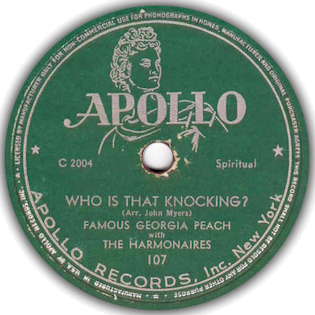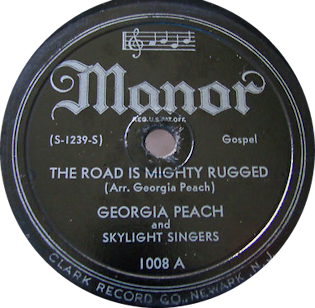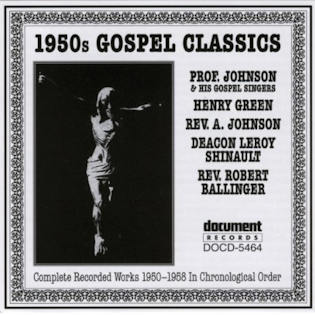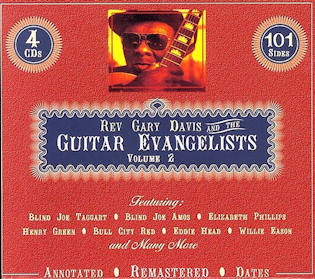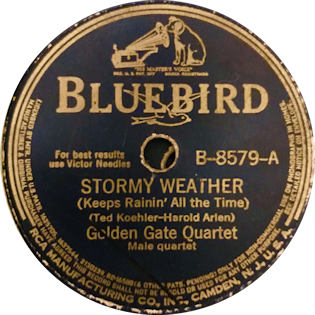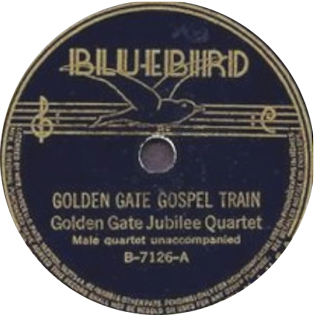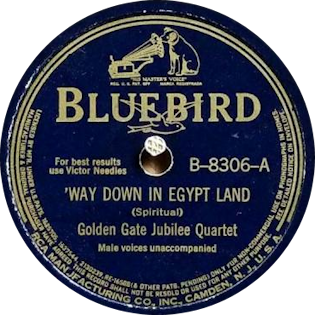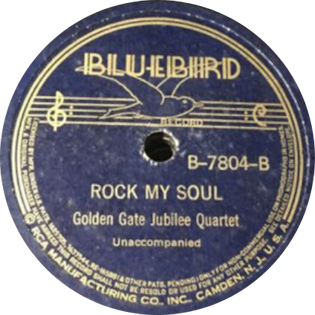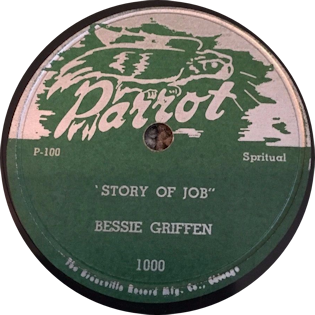 A B C D E F G H I J K L M N O P Q R S T U V W X Y Z
A B C D E F G H I J K L M N O P Q R S T U V W X Y Z
To help with further browsing click on the large ‘Initial’ to return to the Early Gospel Singers Introduction, or click another initial to take you to details of more early gospel singers.
____________________________________________________________________________________________________________________________
| Name: | Deacon W. H. Gallamore and Members of His Congregation |
| Location: | Atlanta, Ga. |
| Born: | ? |
| Died: | ? |
| Biography Synopsis: | “Deacon W.H. Gallamore and his three-member female congregation sound like they were invited into the makeshift recording studio fresh off the street corner. Musically speaking, Gallamore’s gifts to posterity are the most disorganized on this collection, and his approach to rhythm might best be compared with the pacing of a plow horse. Gallamore’s four sermons are quite different from the more straight-laced entries in this collection, and who can resist a title like “Hell Is God’s Chain Gang”?”
– Extract from ALLMusic review of Document CD DOCD5485 “Atlanta, Ga. Gospel (1923-1931)” (Various Artists) |
| Recording career: | 1929 – 4 titles |
| Most popular song(s): | Hell is God’s chain gang
Hide me over in the Rock of Ages In my dying room Just had to tell it |
| References / links: | Discography of American Historical Recordings |
| Images: |  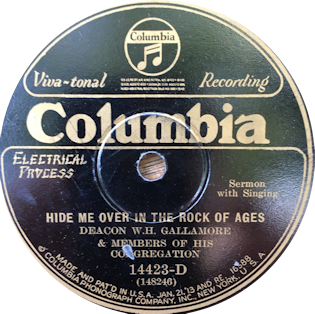 |
| Name: | Rev J.M. Gates |
| Aka: | |
| Born: | 14 July 1884, Hogansville, Georgia |
| Died: | 18 August 1945, Atlanta, Georgia |
| Biography Synopsis: | Rev. J. M. Gates of Atlanta was by far the most recorded preacher prior to World War II. His career began in 1926 and ended fifteen years later with this, his final recorded sermon. It was the eighth sermon he had recorded on a Christmas theme. All of them were variants on the first two, “Death Might Be Your Santa Claus” and “Where Will You Be Christmas Day?” This recording derives mostly from the second theme but it overlaps with the first in its suggestions of death, violence, and the jailhouse. Blues artists sang about Christmas and Santa Claus, and their themes were often equally grim and melancholy. For those on the bottom, Christmas was a reminder of how far down they were. Rev. Gates was born in 1884 and died in 1945. For many years he pastored the Streamline Baptist Church in Atlanta, and his stature was no doubt enhanced by his very successful recording career that included more than 200 songs and sermons. He had the biggest black funeral in Atlanta prior to that of Rev. Martin Luther King, Jr. Gates typically used one male and two female members of his congregation to respond to his sermons and sometimes help in singing a hymn. Their repetitions of his phrases and words of encouragement are typical of traditional African American church services, making this a good example of the style. – Dr. David EvansThe Baptist preacher J.M. Gates was one of the most prolifically recorded black artists of the early 20th century, with over 200 sides on wax between the mid-’20s and his death in 1945 (he once recorded 23 titles in a week, at just two sessions). His sermons and musical numbers appeared on a variety of labels (Victor, Bluebird, Okeh, Gennett), though Gates often re-recorded his most popular sermons – “Death’s Black Train Is Coming,” “Oh Death Where Is Thy Sting,” “Goin’ to Die with the Staff in My Hands” – for multiple labels. Born in 1884, Gates ministered at Atlanta’s Calvary Church and first recorded in 1926. Beginning in April, he recorded almost 100 sides by the end of the year. Understandably, his output slowed slightly during the rest of the late ’20s, and the advent of the Great Depression resulted in a four-year period off records. He returned in 1934, and recorded about 20 more sides until his death in 1945. Experts estimate that Gates recorded at least a quarter of all the sermons that appeared before 1943. – John Bush, All Music Guide (www.allmusic.com)From 1914 to his death, Gates was the pastor of Mount Calvary Baptist Church in Rock Dale Park, Atlanta, Georgia. He had a very prolific recording career, recording over 200 sides between 1926 and 1941, including frequent re-recordings. Experts estimate that at least a quarter of all sermons commercially released on record before 1943 were recorded by Gates. His first best-seller, 1926’s “Death’s Black Train Is Coming”, sold 35,000 copies by the end of its release year. Many of his recordings were strong warnings of the hellish punishments that awaited sinners. Gates is credited with introducing the gospel music of former blues artist Thomas A. Dorsey into the black gospel market via his crusades. His funeral drew the largest crowd of any memorial service in the city before Martin Luther King, Jr. In addition to a Columbia Records collection and a “complete works” set from Document Records, Gates’ work has been frequently featured in gospel and roots music anthologies, including Harry Smith’s influential Anthology of American Folk Music. – Wikipedia (http://en.wikipedia.org/wiki/J._M._Gates) |
| Recording career: | Mid ’20s to his death in 1945 |
| Most popular song(s): | “Death’s Black Train Is Coming” |
| Musical Influences: | |
| References / links: | Wikipedia AllMusicGuide |
| Images: |
| Name: | Rev. H C. Gatewood |
| Location: | |
| Born: | |
| Died: | |
| Biography Synopsis: | ? |
| Recording career: | |
| Most popular song(s): | The New Birth |
| Musical Influences: | |
| References / links: | |
| Images: | 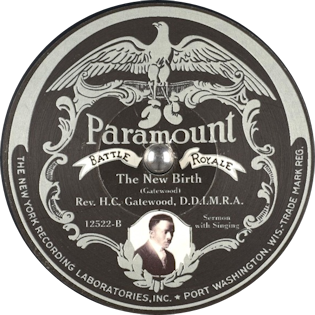 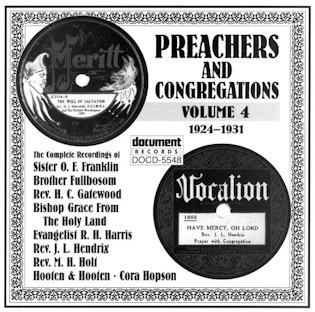 |
| Name: | The Georgia Peach |
| Aka: | Sister Clara Hudmon and Clara Belle Gholston |
| Location: | Georgia |
| Born: | 1899 |
| Died: | 1966 |
| Biography Synopsis: | Sister Clara Hudmon, also known as The Georgia Peach, (October 10, 1899 – 1966) was an American gospel singer. First recording for Okeh Records in 1930, Hudmon is best-remembered for her rendition of Reverend Charles Albert Tindley’s composition “Stand by Me”. She was a member of Reverend J. M. Gates’s congregation and later received notice on the compilation album Harry Smith’s Anthology of American Folk Music, Vol. 4.
Born in Atlanta, Georgia, Hudmon formed a vocal trio with her brothers Ralph and Luther at an early age, and sang in Reverend J. M. Gates’s congregation at Mount Calvary Baptist Church. Hudmon became very established in the religious community, associating with figures such as Claude Joseph Johnson, who later became a reverend and recorded sermons. At age 16, Hudmon quit school and moved in with Reverend T. T. Gholston, working as a nurse for the Reverend’s ailing wife. Just six months after his wife’s death, Gholston married 18 year-old Hudmon, who assumed the role of surrogate mother to the Reverend’s two children. Church members objected to the circumstances of the union, making the family public outcasts, and resulting in the Reverend resorting to alcoholism. After Gholston attempted to deliver a sermon while intoxicated, the family was ostracized from the community, and relocated to Detroit, then New York City. The couple divorced soon after. On December 12, 1930, perhaps as a result of a recommendation by Gates, Hudmon recorded for Okeh Records. Joined by Deacon Leon Davis and Sisters Jordan and Norman, individuals who recorded with Gates between 1927-1930, Hudmon completed, among other compositions, her best-known song: a rendition of Reverend Charles Albert Tindley’s hymn “Stand by Me”. As explained in the book Undercurrent: The Hidden Wiring of Modern Music, Hudmon’s “scarred but studied delivery” helped unveil a new era of gospel music centered around the writings of Tindley and Thomas A. Dorsey. Her cover of “Stand by Me” was collected on Harry Smith’s Anthology of American Folk Music, Vol. 4 in 2000, featured as the first genuine gospel song on the compilation album. Hudmon’s other notable song is her take on “When the Saints Go Marching In”, which was recorded both in 1931 and 1932. Hudmon continued recording throughout the 1930s, sometimes credited as Clara Belle Gholston and Clara Gholston Brock or Brook. Her career was bolstered by a string of successful concerts, particularly an appearance at the Radio City Music Hall, in 1939. Throughout the 1940s, Hudmon recorded under the moniker the Georgia Peach, cutting slides for Decca Records, among other record labels. She recorded until 1960 and died sometime in 1966. Hudmon’s work has since appeared on several compilation albums released on Document Records. In 2005, the Swedish label, Gospel Friend, issued Lord Let Me Be More Humble in This World, a 24-track sampling of her recordings between 1930 and 1960. Source: Wikipedia |
| Recording career: | 1930 – 1960 |
| Most popular song(s): | |
| Musical Influences: | |
| References / links: | Discography of American Historical Recordings |
| Images: |  
|
| Name: | Golden Eagle Gospel Singers |
| Location: | Alabama |
| Biography Synopsis: | An Alabamian a cappella outfit that later developed roots in Chicago, The Golden Eagles were formed in the ’30s by Thelma Byrd. On a level with The Golden Gate Quartet, their popularity was strongest in the Midwest. Unlike other groups of the time, who were usually male and Baptist, this one was coed and Sanctified. Much of their music had a fast-paced blues feel, most notably on 1937’s “Tone the Bell” and 1940’s “He’s My Rock,” which showcased Hammie Nixon on blues harmonica. They recorded for the Decca label.
Source: AllMusicGuide (by Bill Carpenter) |
| Recording career: | 1930s-1940s |
| Most popular song(s): | |
| Musical Influences: | |
| References / links: | YouTube Audio |
| Images: | 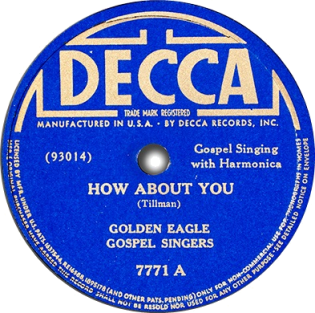  |
| Name: | Golden Gate Jubilee Quartet |
| Location: | SC, NC, New York, etc. |
| Biography Synopsis: | The Golden Gate Quartet (a.k.a. The Golden Gate Jubilee Quartet) is an American vocal group. It was formed in 1931 and, with changes in membership, remains active. It is the most successful of all of the African-American Doo-wop music groups who sang in the jubilee quartet style.
The group was founded as the Golden Gate Jubilee Singers in 1934, by four students at Booker T. Washington High School in Norfolk, Virginia. According to the group’s website, the original members were Willie Johnson (baritone; d. 1980), William Langford (tenor; d. 1970), Henry Owens (second tenor; d. 1970) and Orlandus Wilson (bass; 1917–1998); other sources state that Landford and Wilson replaced earlier members Robert “Peg” Ford and A.C. “Eddie” Griffin in 1935. From 1935, the group sang in churches and on local radio, gaining a regular spot on radio station WIS in Columbia, South Carolina in 1936. They began as a traditional jubilee quartet, combining the clever arrangements associated with barbershop quartets with rhythms borrowed from the blues and jazz like scat singing. They developed a broad repertoire of styles – from Owens’ mournful, understated approach in songs such as “Anyhow” or “Hush, Somebody’s Calling My Name”, to the group’s highly syncopated arrangements in “Shadrach, Meshach and Abednego”. Like The Mills Brothers in popular music, they would often include vocal special effects in their songs, imitating train sounds in songs such as “Golden Gate Gospel Train”. Langford often sang lead, using his ability to range from baritone to falsetto, while Johnson narrated in a hip syncopated style that became the hallmark for the group. Wilson’s bass served as the anchor for the group and Owens harmonized with Langford and Johnson. In 1937 they moved to station WBT in Charlotte, North Carolina, and soon afterwards won a contract with Bluebird Records. After their first recording session on August 14, 1937, in which they recorded 14 songs in two hours, they were contracted to record 12 tracks per year. In 1938, they were recruited by John Hammond to appear at the first From Spirituals To Swing concert held at Carnegie Hall in New York City, after which their popularity grew. An example of their output during this popular period includes a 1938 recording of ‘John the Revelator’ being inducted into the National Recording Registry in 2005. They stayed in New York and were signed up for a residency at the Cafe Society nightclub. As well as performing and recording gospel songs they also recorded some secular songs for RCA Records, who were intending to bill them as “The Four Chocolate Bars”, but the recordings were not released. In 1939, William Langford left the group to form a new group, the Southern Sons; he was replaced by Clyde Riddick (1913–1999). In 1940 the group signed a new contract with Columbia Records’ subsidiary Okeh label, and shortened their name to the Golden Gate Quartet. They soon had a nationwide radio program and the opportunity to sing at Franklin Delano Roosevelt’s inauguration in 1941, becoming the first black musical group to sing at Constitution Hall and later performing several times at the White House. They continued to be popular during World War Two, making several appearances in Hollywood films and singing secular music, including some unique popular front songs such as “Stalin Wasn’t Stallin'” that mixed humor with political commentary. The Quartet appeared in films such as Star Spangled Rhythm (1942), Hit Parade of 1943 (1943), Hollywood Canteen (1944), and the Danny Kaye film A Song Is Born (1948). In the latter film, they performed the songs “Joshua Fit the Battle of Jericho” and part of “A Song Is Born” with Louis Armstrong and Virginia Mayo. Johnson was called into the US Navy in 1943, followed by Wilson in 1944; they were temporarily replaced by Cliff Givens – who later left to join firstly The Ink Spots and then Billy Ward and His Dominoes – and Alton Bradley. The group moved first to the main Columbia record label and then, in 1948, to Mercury Records. Johnson left in 1948 to join The Jubalaires, and was replaced by Orville Brooks (1919-1997). The quartet lost their pre-eminent position in gospel music after the war, when they faced competition from the newer hard gospel quartets. They continued in their old style, offering sharper political commentary in songs such as “God’s Gonna Cut You Down”, but losing much of their audience to quartets such as the Dixie Hummingbirds and the Soul Stirrers. Henry Owens left in 1950 to become a preacher and solo artist. Alton Bradley returned to replace him, but then left in 1952 when he was replaced by Eugene Mumford (1925-1977), previously of The Larks. The Golden Gates revived their career in 1955, however, when they toured Europe for the first time, where they became widely popular. The group moved to Paris in 1959 and has continued touring, primarily in Europe, since then. During his stint in the US Army, in Germany, Elvis Presley, who was a huge admirer of their work since his early childhood, visited them backstage at “Le Casino” in Paris, and stayed to watch their entire show, staying also with them at the hotel “Prince de Galles”. Presley recorded a version of their popular “Swing Down Chariot” that appeared on his His Hand in Mine gospel album. During this time there were further personnel changes: Orville Brooks left and was replaced by Franck Todd and later in turn by Caleb Ginyard (1910-1978), and Eugene Mumford was replaced by Clyde Wright (born May 1, 1928, Charlotte, North Carolina). Since the 1950s, the group has been primarily based in Europe. They toured widely in the late 1950s, including US State Department-sponsored tours around the world. In 1959, the group started a two-year residency at the Casino de Paris. The group made their first tour of Africa in 1962, and during the early 1960s gradually expanded their accompanying band to incorporate guitar, piano, bass and drums. Through the 1960s they toured widely in Europe, with a long-established line-up of Orlandus Wilson, Clyde Riddick, Caleb Ginyard, and Clyde Wright. In 1971, Ginyard and Wright left, and were replaced by Paul Brembly (the great-nephew of Orlandus Wilson) and Calvin Williams. Wright returned to the group in 1985 to replace Williams, who returned to the US. Bill “Willie” Johnson worked with Eugene Mumford and Cliff Givens in his own version of The Golden Gate Quartet in the late ’70s out of the Los Angeles area, most notably appearing on Ry Cooder’s “Jazz” album, and appearing with Cooder in his 1978 “Soundstage” performance, with Givens, Pico Payne, and Jimmy Adams (though Johnson didn’t use the group name in these particular appearances). The group undertook a 60th anniversary world tour in 1994. Riddick remained with the group until his retirement in 1995, and Wilson, the last surviving member of the original group, until his death in 1998. Riddick was replaced by Frank Davis. Wright was replaced by Charles West (Nephew to Wilson) of Portsmouth, VA. The position of bass singer has in recent years been filled by Thierry Fred François, Richard Phillips, and, since 2005, by Anthony Gordon. The Golden Gate Quartet was inducted into The Vocal Group Hall of Fame in 1998. In his 2011 album “So Beautiful or So What” musician Paul Simon used excerpts from their 1938 recording of “Golden Gate Gospel Train” to mix into the song “Love & Blessings”. In addition, the group’s music was also featured in the video game Battlefield Bad Company. Source: Wikipedia |
| Recording career: | 1937 – present |
| Most popular song(s): | |
| Musical Influences: | |
| References / links: | YouTube Audio |
| Images: | 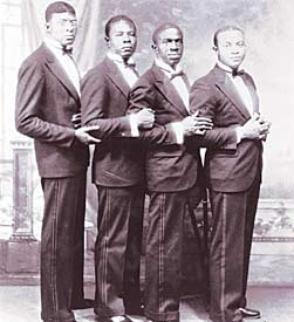 
|
| Name: | Gospel Camp Meeting Singers |
| Aka: | Georgia Tom Dorsey and Tampa Red |
| Location: | Chicago, Il |
| Biography Synopsis: | |
| Recording career: | Two songs recorded May 1929 |
| Most popular song(s): | |
| Musical Influences: | |
| References / links: | |
| Images: |
| Name: | Blind Roosevelt Graves |
| Location: | Hattiesburg, Mississippi |
| Born: | 1909 |
| Died: | 1962 |
| Biography Synopsis: | Le Moise Roosevelt Graves (December 9, 1909, Meridian, Mississippi – December 30, 1962, Gulfport, Mississippi), credited as Blind Roosevelt Graves, was an American blues guitarist and singer, who recorded both sacred and secular music in the 1920s and 1930s.
On all his recordings, he played with his brother Uaroy Graves (c.1912–c.1959), who was also nearly blind and played the tambourine. They were credited as “Blind Roosevelt Graves and Brother”. Their first recordings were made in 1929 for Paramount Records. Theirs is the earliest version recorded of “Guitar Boogie”, and they exemplified the best in gospel singing with “I’ll Be Rested”. Blues researcher Gayle Dean Wardlow has suggested that their 1929 recording “Crazy About My Baby” “could be considered the first rock ‘n’ roll recording.” In July 1936, they were located by the talent broker H. C. Speir, who arranged for them to record in Hattiesburg, Mississippi, according to some sources at the train station, although Speir later told Wardlow that the recordings took place in a temporary studio, in the Hotel Hattiesburg, at Mobile Street and Pine Street. For the session they were joined by the local piano player Cooney Vaughn, who performed weekly on radio station WCOC in Meridian prior to World War II. The trio were billed on record as the Mississippi Jook Band. In all, they recorded four tracks at Hattiesburg for the American Record Company – “Barbecue Bust”, “Hittin’ The Bottle Stomp”, “Dangerous Woman” and “Skippy Whippy”. According to the Rolling Stone Illustrated History of Rock and Roll, these “…featured fully formed rock & roll guitar riffs and a stomping rock & roll beat”. The Graves Brothers did not record again. After the war, Roosevelt Graves is thought to have moved to Gulfport, Mississippi. For a number of years, the subject of Uaroy’s identity was disputed. In several books, magazine articles, and album liner notes that mentioned the Graves brothers, the names “Aaron” or “Leroy” were substituted for Uaroy, on the assumption that the otherwise unknown name Uaroy must have arisen due to the poor penmanship of a In October 2008, the recordings by the Graves brothers and the Mississippi Jook Band, and others who recorded in Hattiesburg, were commemorated by a marker on the Mississippi Blues Trail, established to preserve the state’s musical heritage. Source: Wikipedia |
| Recording career: | |
| Most popular song(s): | |
| Musical Influences: | |
| References / links: | YouTube Audio |
| Images: | 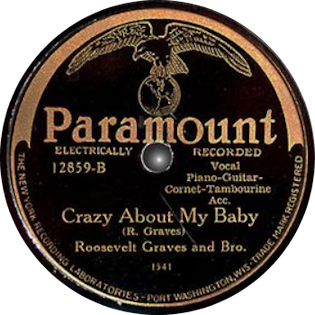 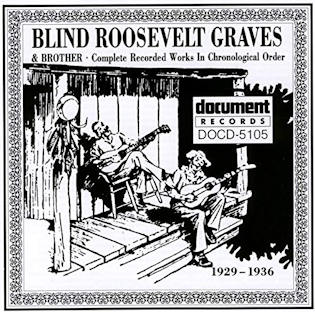 |
| Name: | A A. Gray and Seven Foot Dilly |
| Location: | |
| Born: | |
| Died: | |
| Biography Synopsis: | |
| Recording career: | |
| Most popular song(s): | |
| Musical Influences: | |
| References / links: | |
| Images: |
| Name: | Great Day (Of) New Orleans Singers |
| Location: | New Orleans, LA |
| Biography Synopsis: | Great Day New Orleans Singers (Vocal group) with Clarence Williams (leader), James P. Johnson (instrumentalist : piano) |
| Recording career: | 1929 |
| Most popular song(s): | “Great Day” |
| References / links: | Discography of American Historical Recordings |
| Images: | 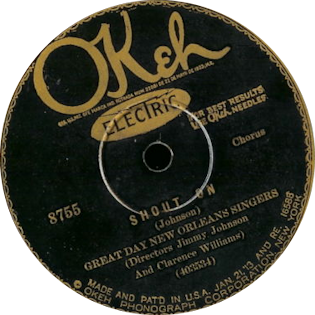 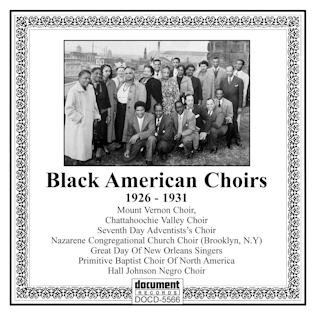 |
| Name: | Rev. Sutton Griggs |
| Location: | |
| Born: | |
| Died: | |
| Biography Synopsis: | |
| Recording career: | |
| Most popular song(s): | |
| Musical Influences: | |
| References / links: | |
| Images: |
| Name: | John & Lovie Griffin |
| Location: | |
| Born: | |
| Died: | |
| Biography Synopsis: | |
| Recording career: | |
| Most popular song(s): | |
| Musical Influences: | |
| References / links: | |
| Images: |
| Name: | Rev. Gipson |
| Location: | |
| Born: | |
| Died: | |
| Biography Synopsis: | |
| Recording career: | |
| Most popular song(s): | |
| Musical Influences: | |
| References / links: | |
| Images: |
____________________________________________________________________________________________________________________________
 A B C D E F G H I J K L M N O P Q R S T U V W X Y Z
A B C D E F G H I J K L M N O P Q R S T U V W X Y Z
To help with further browsing click on the large ‘Initial’ to return to the Early Gospel Singers Introduction, or click another initial to take you to details of more early gospel singers.
____________________________________________________________________________________________________________________________
Please Note:
As this is a continuously developing website, several entries only give the names with no biographical details. Please be patient as these entries are included for completeness, indicating the details are ‘coming soon’ and will be added when time allows.
If there are any early (pre war) gospel singers missing from the lists that you think should be included, please email the details to alan.white@earlygospel.com. Thank you in advance for your assistance.

